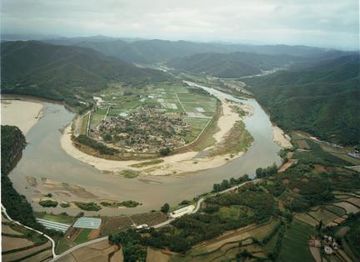안동 하회마을
| 안동 하회마을 Hahoe Village, Andong |
|
 안동 하회마을, 국가문화유산포털, 문화재청. |
|
| 대표명칭 | 안동 하회마을 |
|---|---|
| 영문명칭 | Hahoe Village, Andong |
| 한자 | 安東 河回마을 |
| 주소 | 경상북도 안동시 풍천면 하회리 |
| 지정(등록) 종목 | 국가민속문화재 제122호 |
| 지정(등록)일 | 1984년 1월 14일 |
| 분류 | 유적건조물/주거생활/주거건축/마을 |
| 시대 | 조선시대 |
| 수량/면적 | 1,577필지/6,495,535㎡ |
| 웹사이트 | 안동 하회마을, 국가문화유산포털, 문화재청. |
|
|
|
해설문
기존 국문
이 마을은 풍산류씨가 600여 년간 대대로 살아온 한국의 대표적인 동성마을이며, 와가와 초가가 오랜 역사 속에서도 잘 보존된 곳이다. 특히 조선시대 대유학자인 류운룡과 임진왜란 때 영의정을 지낸 류성룡 형제가 태어난 곳으로도 유명하다.
마을 이름을 하회(河回)라고 한 것은 낙동강이 ‘S’자 모양으로 마을을 감싸 안고 흐르는 데서 유래되었다. 하회마을은 형국상으로 태극형‧연화부수형‧행주형에 해당하며, 이미 조선시대부터 사람이 살기에 가장 좋은 곳으로도 유명하였다. 마을의 동쪽에 태백산에서 뻗어 나온 해발 327m의 화산(花山)이 있고, 이 화산의 줄기가 낮은 구릉지를 형성하면서 마을의 서쪽 끝까지 뻗어있으며, 수령이 600여 년 된 삼신당 느티나무가 있는 지역이 마을에서 가장 높은 중심부에 해당한다.
하회마을의 집들은 삼신당 느티나무를 중심으로 강을 향해 배치되어 있기 때문에 좌향이 일정하지 않다. 한국의 다른 마을들의 집들이 정남향 또는 동남향을 하고 있는 것과는 상당히 대조적인 모습이다. 또한 큰 와가를 중심으로 주변의 초가들이 원형을 이루며 배치되어 있는 것도 특징이라 하겠다.
하회마을에는 서민들의 놀이인 ‘하회별신굿탈놀이’와 선비들의 풍류놀이인 ‘선유줄불놀이’가 현재까지도 온전히 전승되고 있고, 우리나라의 전통생활 문화와 고건축양식을 잘 보여주는 문화유산들이 잘 보존되어 있다.
수정 국문
하회(河回)라는 마을 이름은 물이 돌아 흐른다는 뜻을 담고 있다. 낙동강 상류인 화천이 ‘S’자 모양으로 마을을 감싸 안고 흐르는 데서 생겨났다. 태극 모양 혹은 연꽃이 물에 떠 있는 형상으로 예로부터 좋은 땅으로 여겨지는 곳이다.
이 마을은 한국의 대표적인 씨족 마을로, 고려 중기에 김해허씨와 광주안씨, 14세기 고려 말에 풍산류씨가 들어와 마을을 이루었다. 이후 풍산류씨를 중심으로 마을이 번성하였으며, 특히 조선시대의 문신, 학자인 류운룡(柳雲龍, 1539~1601)과 류성룡(柳成龍, 1542~1607) 형제가 태어난 곳으로 유명하다.
하회마을에는 우리나라의 고건축 양식과 전통적인 생활 모습을 보여주는 문화유산들이 잘 보존되어 있다. 류씨 문중의 고택에서는 조선시대 양반가의 전통과 의례가 유지되고 있으며, 마을 주민들은 ‘하회별신굿탈놀이’, ‘선유줄불놀이’ 등 서민과 선비들의 공동체 놀이를 현재까지도 온전히 전승하고 있다. 하회마을은 자연과 조화를 이루는 살아있는 문화유산으로서의 가치를 인정받아 2010년 유네스코 세계유산으로 등재되었다.
영문
Hahoe Village is one of Korea's most representative clan villages. It is comprised of 127 properties built in the traditional Korean style. Among them, 12 are designated as state and provincial cultural heritages. The village's tangible heritages, such as its pavilions, study halls, Confucian academies, upper-class residential estates, and thatched-roofed houses of commoners, have been well maintained over the past centuries. The village's intangible heritages, such as traditional rituals and customs of the Joseon period (1392-1910), are also still performed by the villagers. For these reasons, Hahoe Village was inscribed on the UNESCO World Heritage List in 2010.
A "clan village" is settled in over the centuries by a family lineage founded by a patriarch. The primary lineage of first-born male descendants, called the "head family," would live in the clan village, which would serve as a home base for the clan's Confucian education and ancestral rituals.
Hahoe Village was established in the middle period of the Goryeo dynasty (918-1392) when the Gimhae Heo clan and the Gwangju An clan moved to this area. In the late 14th century, the Pungsan Ryu clan also settled here. The village thrived following the success of two brothers born in this village, Ryu Un-ryong (1539-1601) and Ryu Seong-ryong (1542-1607), who became esteemed scholar-officials who brought prestige to their family.
This village's geographical location has long been regarded as auspicious. The village's name, Hahoe, means "encircled by the river," because the Nakdonggang River flows around the village in an S-shape.
The village is also known for its mask dance drama, a musical folk play that satirizes the hypocrisies of society, and its firework boat festival, in which Buyongdae Cliff is lit ablaze under the summer full moon and people enjoy song, dance, and poetry while riding on boats. Other important village heritages include the masks used during the mask dance drama and Ryu Seong-ryong's written record of the Japanese invasions of 1592-1598.